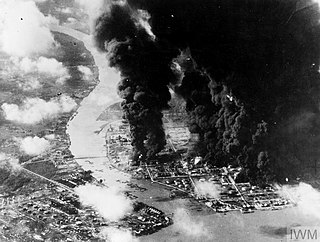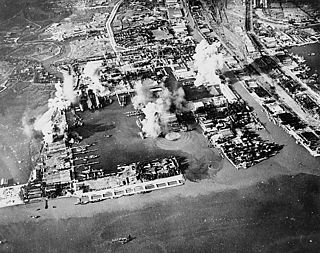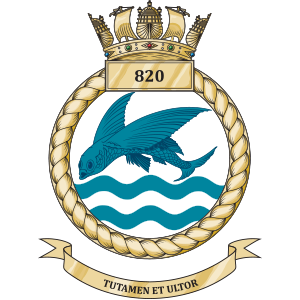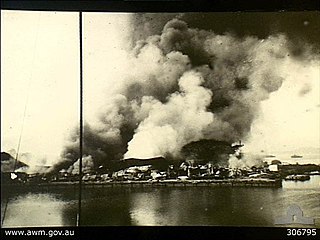Related Research Articles

The Asiatic-Pacific Theater was the theater of operations of U.S. forces during World War II in the Pacific War during 1941–1945. From mid-1942 until the end of the war in 1945, two U.S. operational commands were in the Pacific. The Pacific Ocean Areas (POA), divided into the Central Pacific Area, the North Pacific Area and the South Pacific Area, were commanded by Fleet Admiral Chester W. Nimitz, Commander-in-Chief Pacific Ocean Areas. The South West Pacific Area (SWPA) was commanded by General of the Army Douglas MacArthur, Supreme Allied Commander South West Pacific Area. During 1945, the United States added the United States Strategic Air Forces in the Pacific, commanded by General Carl A. Spaatz.

The British Pacific Fleet (BPF) was a Royal Navy formation that saw action against Japan during the Second World War. It was formed from aircraft carriers, other surface warships, submarines and supply vessels of the RN and British Commonwealth navies in November 1944.

849 Naval Air Squadron was a squadron of the Fleet Air Arm, the Air Arm of the British Royal Navy. It was formed during the Second World War as a carrier based torpedo-bomber, unit, flying missions against Japanese targets in the Far East. Its service since the Second World War has been as an airborne early warning squadron, flying fixed winged Skyraiders and Gannets from the Royal Navy's fixed wing carriers from 1952 until 1978, and airborne early warning Sea King helicopters from 1982 to 2018.

USS Bulmer (DD-222/AG-86) was a Clemson-class destroyer in the United States Navy during World War II. It was the last warship of the Asiatic Fleet in USN commission.

Operation Meridian, also known as the "Palembang Raids" was part of a series of British air attacks directed at Japanese-held oil refineries near Palembang on Sumatra during the Second World War, Meridian had two phases: Meridian I on 24 January 1945 and Meridian II on 29 January. As a result, the critical aviation fuel output of the plants at Palembang was reduced by seventy-five percent.

Operation Transom was an attack by Allied forces against the Japanese-occupied city of Surabaya on the Indonesian island of Java during World War II. Conducted by the British-led Eastern Fleet, the operation took place on 17 May 1944 and involved American and British carrier-based aircraft bombing the city's docks and an oil refinery. An American torpedo bomber was shot down, and two British torpedo bombers were lost in accidents.

HMS Wakeful was a W-class destroyer of the Royal Navy launched in 1943. She saw service during the Second World War and was later converted into a Type 15 fast anti-submarine frigate. She was sold for scrap in 1971.

The Battle of Palembang was a battle of the Pacific theatre of World War II. It occurred near Palembang, on Sumatra, on 13–15 February 1942. The Royal Dutch Shell oil refineries at nearby Plaju were the major objectives for the Empire of Japan in the Pacific War, because of an oil embargo imposed on Japan by the United States, the Netherlands, and the United Kingdom after the Japanese invaded China. With the area's abundant fuel supply and airfield, Palembang offered significant potential as a military base to both the Allies and the Japanese.

The Kawasaki Ki-48, was a Japanese twin-engine light bomber that was used during World War II. Its Allied reporting name was "Lily".

820 Naval Air Squadron is a Royal Navy Fleet Air Arm carrier-based squadron flying the AgustaWestland Merlin HM2 in Anti-Submarine and Airborne Early Warning (AEW) roles from RNAS Culdrose.

Operation Lentil was an air raid by British carrier-based aircraft on oil installations at Pangkalan Brandan, an important centre for Indonesian oil production on Sumatra on 4 January 1945. It was part of the larger Operation Outflank, and its aim was to disrupt fuel supplies to Japanese forces in the Pacific.

The Invasion of Sumatra was the assault by Imperial Japanese forces on the Dutch East Indies that took place from 14 February to 28 March 1942. The invasion was part of the Pacific War in South-East Asia during World War II and led to the capture of the island. The invasion of Sumatra was planned to occur prior to the invasion of Java to destroy the west flank of the allies and to give access to Java.
Vice Admiral Sir Roy William "Gus" Halliday, was a British naval pilot who saw service in the Second World War, in the British Pacific Fleet and subsequently became Director-General Intelligence in Britain's Defence Intelligence Staff from 1981 to 1984.

William Henry Isaac Atkinson DSC, CD was the highest scoring fighter ace of the Royal Canadian Navy during the Second World War and the last pilot from The Commonwealth to become an ace during the war. Atkinson claimed six aircraft destroyed and two shared. During the war he was awarded the Distinguished Service Cross and was Mentioned in Despatches. Remaining in the navy after the war he was awarded the Canadian Forces Decoration and clasp.

The Eastern Fleet, later called the East Indies Fleet, was a fleet of the Royal Navy which existed between 1941 and 1952.
Operation Robson was the first of a series of aerial operations, Operation Outflank, undertaken by the British Pacific Fleet (BPF) against the oil refineries of Japanese-occupied Sumatra during World War II. Admiral Chester Nimitz, Commander in Chief, Pacific Ocean Areas, proposed a strike on the refineries to Admiral Bruce Fraser, commander of the BPF, during a meeting in early December.
887 Naval Air Squadron was a Naval Air Squadron of the Royal Navy's Fleet Air Arm.

1833 Naval Air Squadron was a Naval Air Squadron of the Royal Navy's Fleet Air Arm between 1943 and 1945 and then again from 1947 to 1957.

Operation Boomerang was a partially successful air raid by the United States Army Air Forces' (USAAF) XX Bomber Command against oil refining facilities in Japanese-occupied Dutch East Indies during World War II. The attack took place on the night of 10/11 August 1944 and involved attempts to bomb an oil refinery at Palembang and lay mines to interdict the Musi River.
References
- Winton, John (1970). The Forgotten Fleet: The British Navy in the Pacific, 1944–1945. New York: Coward-McCann.
- Operation Outflank - Codenames : Operations of WW2